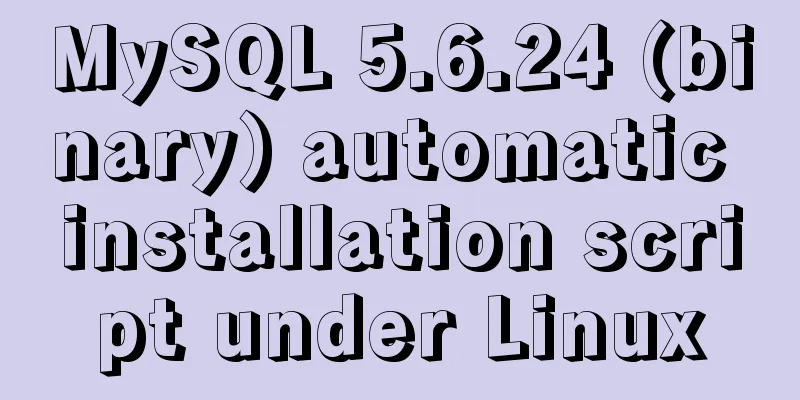MySQL 5.6.24 (binary) automatic installation script under Linux

|
This article shares the mysql5.6.24 automatic installation script code in Linux environment for your reference. The specific content is as follows illustrate: 1. This script is for testing only . If you want to use it in a formal environment, you need to change some parameters of the script. 2. Before using this script, you need to ensure that the Linux environment can be downloaded online . If you cannot connect to the Internet, you need to upload the downloaded MySQL binary package to the /data directory in Linux. 3. To use the script, you need to enter three parameters at a time: 1. The MySQL version number to be installed, such as: 5.6.24 2. The mysql port setting to be installed, such as: 3306 3. Set the server_id of mysql, such as: 1003306 Steps: 1. Upload the following script to the Linux environment. I personally named it mysql_install.sh #!/bin/bash #mysql_install by chen #Email: [email protected] & [email protected] #version 2.0 #Install version 5.6.20-5.6.25 #Installation requirements: #You need to be able to connect to the Internet. If there is no network, you can create the /data directory first and upload the installation package to the /data directory. #Judge whether the /data directory exists. If not, create it and download mysql datamenu="/data" read -p "Input a mysql version:" -t 30 mysql_version read -p "Input a mysql port:" -t 30 mysql_port read -p "Input a mysql_server_id:" -t 30 mysql_server_id mysqlfile="$datamenu/mysql-$mysql_version-linux-glibc2.5-x86_64.tar.gz" if [ ! -d "$datamenu" ];then mkdir "$datamenu" wget -P /data http://dev.mysql.com/get/Downloads/MySQL-5.6/mysql-$mysql_version-linux-glibc2.5-x86_64.tar.gz elif [ ! -f "$mysqlfile" ];then wget -P /data http://dev.mysql.com/get/Downloads/MySQL-5.6/mysql-$mysql_version-linux-glibc2.5-x86_64.tar.gz fi #Unzip the downloaded mysql cd /opt mkdir mysql cd mysql tar zxvf $mysqlfile -C /opt/mysql #Create mysql user egrep "^mysql" /etc/group >& /dev/null if [ $? -ne 0 ] then groupadd mysql fi #create user if not exists egrep "^mysql" /etc/passwd >& /dev/null if [ $? -ne 0 ] then useradd -g mysql -s /sbin/nologin -d /usr/local/mysql mysql fi #Create a mysql soft connection and authorize the mysql user cd /usr/local/ rm -rf /usr/local/mysql ln -s /opt/mysql/mysql-$mysql_version-linux-glibc2.5-x86_64 /usr/local/mysql chown -R mysql:mysql /usr/local/mysql chown -R mysql:mysql /usr/local/mysql/ #Based on the configuration file, create the mysql installation directory and authorize mkdir -p /data/mysql mkdir -p /data/mysql/mysql${mysql_port} cd /data/mysql/mysql${mysql_port}/ mkdir /data/mysql/mysql${mysql_port}/data mkdir /data/mysql/mysql${mysql_port}/logs mkdir /data/mysql/mysql${mysql_port}/tmp chown -R mysql:mysql /data/mysql/mysql${mysql_port} cat > /etc/my.cnf << EOF [client] port = ${mysql_port} socket = /tmp/mysql.sock # The MySQL server [mysqld] # Basic port = ${mysql_port} user = mysql basedir = /usr/local/mysql datadir = /data/mysql/mysql${mysql_port}/data tmpdir = /data/mysql/mysql${mysql_port}/tmp socket = /tmp/mysql.sock log-bin = /data/mysql/mysql${mysql_port}/logs/mysql-bin log-error = error.log slow-query-log-file = slow.log skip-external-locking skip-name-resolve log-slave-updates lower_case_table_names = 1 #Ignore table name case character_set_server = gbk innodb_file_per_table = 1 innodb_autoinc_lock_mode = 2 explicit_defaults_for_timestamp = true sql_mode=NO_ENGINE_SUBSTITUTION,STRICT_TRANS_TABLES EOF # Initialize mysql cd /usr/local/mysql ./scripts/mysql_install_db --defaults-file=/etc/my.cnf #Create mysql startup script under /etc/init.dcp /usr/local/mysql/support-files/mysql.server /etc/init.d/mysql #Add environment variables and make the /etc/profile environment variables effective echo "export PATH=$PATH:/usr/local/mysql/bin">>/etc/profile export PATH=$PATH:/usr/local/mysql/bin 2. Give the script executable permissions. [root@zabbix-server ~]# rz -yz waiting to receive.**B0100000023be50 [root@zabbix-server ~]# ls anaconda-ks.cfg install.log install.log.syslog mysql_install.sh [root@zabbix-server ~]# chmod +x mysql_install.sh [root@zabbix-server ~]# ls -al|grep mysql_install.sh -rwxr-xr-x. 1 root root 3136 Jul 29 10:29 mysql_install.sh 3. Execute the script, enter three parameters, and wait for the database to be installed [root@MySQL ~]# ./mysql_install.sh Input a mysql version:5.6.24 Input a mysql port:3306 Input a mysql_server_id:1003306 4. Start the database [root@MySQL ~]# /etc/init.d/mysql start Starting MySQL.. [ OK ] [root@zabbix-server ~]# mysql Welcome to the MySQL monitor. Commands end with ; or \g. Your MySQL connection id is 1 Server version: 5.6.24-log MySQL Community Server (GPL) Copyright (c) 2000, 2015, Oracle and/or its affiliates. All rights reserved. Oracle is a registered trademark of Oracle Corporation and/or its affiliates. Other names may be trademarks of their respective owners. Type 'help;' or '\h' for help. Type '\c' to clear the current input statement. mysql> show databases -> ; +--------------------+ | Database | +--------------------+ | information_schema | |mysql | | performance_schema | | test | +--------------------+ 4 rows in set (0.00 sec) mysql> At this point, the MySQL installation under Linux has been completed, and you can use it to do some tests. The above is the full content of this article. I hope it will be helpful for everyone’s study. I also hope that everyone will support 123WORDPRESS.COM. You may also be interested in:
|
>>: Detailed explanation of JS homology strategy and CSRF
Recommend
CentOS7.x uninstall and install MySQL5.7 operation process and encoding format modification method
1. Uninstalling MySQL 5.7 1.1查看yum是否安裝過mysql cd y...
Summary of common knowledge points required for MySQL
Table of contents Primary key constraint Unique p...
MySQL database JDBC programming (Java connects to MySQL)
Table of contents 1. Basic conditions for databas...
Solution to 1067 when Mysql starts in Windows
I just started working a few days ago and install...
mysql5.5 installation graphic tutorial under win7
MySQL installation is relatively simple, usually ...
Talking about ContentType(s) from image/x-png
This also caused the inability to upload png files...
Detailed explanation of CSS3 flex box automatic filling writing
This article mainly introduces the detailed expla...
How to strike a balance between ease of use and security in the login interface
Whether you are a web designer or a UI designer, ...
JD Vue3 component library supports the detailed process of mini program development
Source code preview: https://github.com/jdf2e/nut...
css3 animation ball rolling js control animation pause
CSS3 can create animations, which can replace man...
js to realize a simple advertising window
This article shares the specific code of js to im...
Vue implements the drag and drop sorting function of the page div box
vue implements the drag and drop sorting function...
The whole process of developing a Google plug-in with vue+element
Simple function: Click the plug-in icon in the up...
MySQL server 5.7.20 installation and configuration method graphic tutorial
This article records the installation and configu...
Robots.txt detailed introduction
Robots.txt is a plain text file in which website ...









